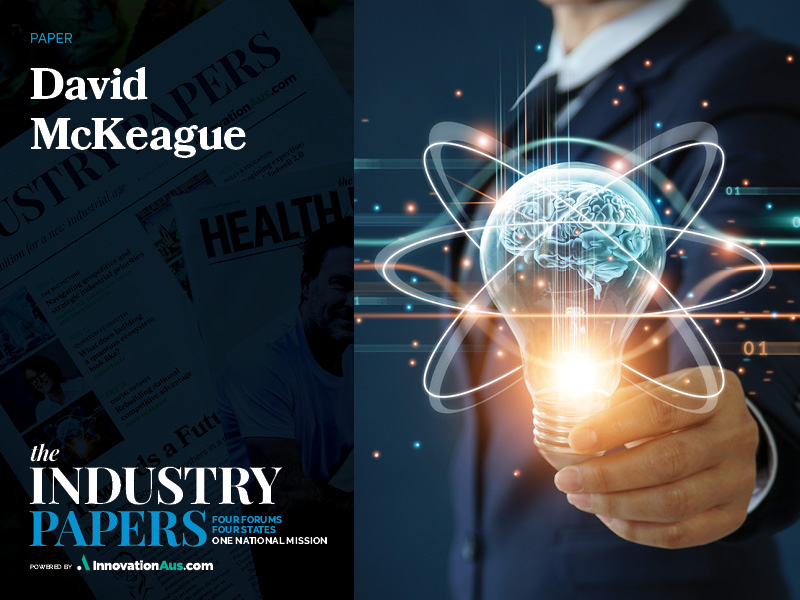Australia has had a competitively thinning economy over the last 30 years. Australian corporates have reduced inhouse research and development – Telstra Research, Comalco Research, Wormald Research are just a few examples – which has impacted Australian university research labs. Australian venture investment is now one-third of what it should be, and the university research lab-to-real-world value creation is now weak.
Australia is rich in resources and sunshine, but how far up the value chain can we go? What new value chains can we participate in?

In The Competitive Advantage of Nations the management guru Michael Porter said: “National prosperity is created, not inherited. It does not grow out of a country’s natural endowments, its labour pool, its interest rates, or its currency’s value, as classical economics insists.” I believe it’s time to revisit our thinking on creating unfair competitive advantages and find ways to combine Australia’s competitive advantages in such a way that they generate a national ‘unfair advantage’.
What new strengths do we need to add to rebuild meaningful competitive advantage and how should we think about it? Australia’s strength is not in the low-cost quadrant but must be in the value-added or premium quadrant.
But this time let’s also consider creating unfair advantages approaches and techniques from the technology world. In addition, how does one build and improve on powerful new business models?
The global digital tech industry grew rapidly in the same 30 years where the Australian industry’s competitiveness thinned. As at May 2024, Alphabet, Amazon, Apple, Meta, Microsoft, Nvidia and Tesla have a combined market capitalisation of US$13 trillion. What lessons can we extract?
Alphabet’s search algorithm, Amazon’s logistics network, the software platforms of Microsoft and Meta, Apple’s design process and vertical integration, have created immense competitive advantage for these companies. Tesla has advantages in its software platform, battery, and vertical integration and Nvidia its hardware.
These companies started whole new industry categories but also competed and won against existing incumbents with their powerful new value propositions and business models. Can Australia learn from this “magnificent seven”? I believe it can.
The strategic use of network effects, vertical integration of supply chains, leveraging connected software platforms and intelligent partnering has led to a winners-take-all series of businesses that will just continue to grow.
A business is ultimately defined by its customers. Having a deep understanding of its customers’ needs through customer discovery is core business. Insight into customer needs is key. But Australia is very disconnected from the international supply chains and markets. Can we eliminate this weakness by building our own customer information network effects?
The AI boom represents a special opportunity which means that new winners-take-all effects are again up for grabs. The traditional tech giants are currently protecting themselves against the innovator’s dilemma, but we should expect new business model innovations which incorporate AI. Hence the vital interest in building or applying AI to business models to generate network effects and customer insights.
How do we combine these strategic patterns and combine them into Australian unique use cases?
For example, can we reimagine new materials into new value chains? Could we develop a national vanadium flow storage industry for long duration energy storage and capture the entire value chain (minerals through to storage), not just a component? Economist, academic and author of The Competitive Advantage of Nations, Michael E. Porter, has said: “Strategy is about making choices; it’s about deliberately choosing to be different.”
How do we choose to be different but also remain aligned to our strengths? Can we layer these competitive advantages into unfair advantages? The world has shifted. What was a competitive advantage 30 years ago is now a maintenance factor. It’s constant effort and searching, rebuilding and finding new competitive advantages.
Typically, the government perspective on national competitive advantage starts with a top-down perspective but crucially a new competitive advantage is identified and generated bottom-up from the industry participants. To make this work we need an ongoing conversation from government and industry on what we need to do to generate a layered set of moats to form a national Unfair Advantage.
A competitive advantage isn’t absolute, it’s about relative advantage to our competitors. If China or USA are large, fast, innovative economies, Australia needs to focus on our relative advantage, for example being nimble, specialised, with earned secrets. Do we need to shift our points of differentiation away from our competitors to ones which uniquely fit our culture? Unique know-how, proprietary technology, strong customer relationships, a highly skilled and experienced workforce, and a strong brand reputation are some of the forms our competitive advantage could take.
Let’s explore three sources of advantage – earned secrets, innovation velocity and how software engineering can be adopted as an advantage.
Earned secrets are advantages that are developed over time through deep insights and continuous improvements. They are not easily understood or replicated by competitors and can provide a sustainable competitive advantage. Earned secrets are generally not obvious and are hidden. They are valuable because they can only be acquired through circumstance or hard work. They come in two flavours, either ideas that other people couldn’t have discovered, or realisations about secrets hidden in plain sight. An example may be to arbitrage consumer marketing and adapt for enterprise marketing. It’s become a non-obvious secret advantage.
Earned secrets must be constantly nurtured and improved to remain relevant and valuable. Companies that fail to do so may find themselves losing their competitive advantage to rivals who have developed their own earned secrets.
We need to improve our innovation velocity. We need to work in terms of weeks not months or years. Let’s think boldly about how we can generate targeted research spinouts in weeks, not years. For example, simple transparent contractual terms will enhance national innovation velocity.
Software engineering is the key to both deep cost reduction and scalable network effects. Building an advantage around software engineering is the key to all platforms, drones, factory automation, robotics, quantum, enterprise, defence, government, and cybersecurity. Software engineering is the lubrication a competitive advantage around software requires.
We do have a number of national weaknesses which we need to think about. Novel research that remains stuck in labs, a weak product building culture that fails to reliably package research into systems and services that can be used by customers, failure to commercialise research, and a weak domestic venture funding environment are some. We also need to increase the pace growth in our entrepreneurial environment, empower small, high-performance teams and blow aware the barriers presented by a destructive bureaucrat mindset which slows progress.
Let’s look carefully at these weaknesses and either neutralise them or turn them into national competitive advantages.
We should combine multiple competitive tactics, when it makes sense, to create an overwhelming unfair advantage. Unfairly cheaper innovative products like electric vehicles from China spring from a vertical supply chain where value can be integrated and passed through at extremely low cost to consumers when it is combined with a devalued currency.
Let’s learn from the successes of others and recognise and start thinking harder about building deeper competitive advantages, moats and earned secrets to build national unfair advantages.
We need a willingness not just to compete globally but to think, plan and execute on how to strategically win globally. It all starts with a winning mindset. A mindset for building a national unfair advantage.
We need to create a series of distinctly different strategic patterns that are not even, that play to Australia’s strengths and where we have weaknesses that are vital to winning, we need to concentrate on neutralising or improving them.
We should start a deeper strategic national conversation around creating our strategic competitive advantages, moats, and earning new secrets. For example, low-cost energy is a key advantage, if we swap to green premium energy, how do we leverage that? Discussions between government and industrial players should be robust. Let’s build strategic advantages that are unique, powerful, and designed to win. We need to adopt a mindset of continual improvement for unique Australian competitive advantages.
Let’s start a national discussion on creating and building an Australian unfair advantage.
David McKeague is a serial tech entrepreneur with more than 30 years’ experience in building AI systems and businesses. For the last 10 years, David has founded AI startups including co-founding Curious Thing AI, an Australian AI scaleup that provides voice Gen AI services for the enterprise. He has also been involved Australian research spinout companies Incoming and Nitero, which was acquired by semiconductor leader AMD.
This article is part of The Industry Papers publication by InnovationAus.com. Order your hard copy here. 36 Papers, 48 Authors, 65,000 words, 72 page tabloid newspaper + 32 page insert magazine.
The Industry Papers is a big undertaking and would not be possible without the assistance of our valued sponsors. InnovationAus.com would like to thank Geoscape Australia, The University of Sydney Faculty of Science, the Semiconductor Sector Service Bureau (S3B), AirTrunk, InnoFocus, ANDHealth, QIMR Berghofer, Advance Queensland and the Queensland Government.
Do you know more? Contact James Riley via Email.

